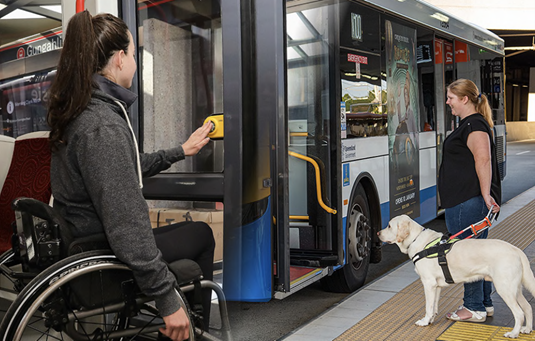Reform of the Disability Standards – Consultation Regulation Impact Statement
The Disability Standards for Accessible Public Transport 2002 (the ‘Transport Standards’), made under the Disability Discrimination Act 1992 (DDA), seeks to remove discrimination for people with disability in relation to public transport services, including trains, trams (including light rail), buses, ferries, aircraft, taxis and dial-a-ride services.[1] The Transport Standards are designed to provide certainty to providers and operators of public transport services and infrastructure about their responsibilities under the DDA.
The effectiveness and efficiency of the Transport Standards are reviewed every five years. The second review, undertaken by the then Department of Infrastructure and Regional Development in 2012, has as a key recommendation to ‘modernise’ the Transport Standards. The Australian Government recognised that, after more than a decade since their adoption, the Transport Standards may not be meeting the current and future needs of people with disability, nor provide sufficient flexibility, clarity, or guidance to transport designers, operators, and providers to practically fulfill their obligations under the DDA. As such, the Australian Government supported the review’s recommendation to modernise and improve the Transport Standards.
As access consultants working as accessibility advisors in the Transport Industry, Architecture & Access recognises the inadequacies of the Transport Standards in its current form and have wholly supported this process through our submission in April 2021.
The modernisation is being undertaken in two stages of proposed amendments to the current Transport Standards. The first stage of proposed amendments is the subject of this Consultation Regulation Impact Statement (Consultation RIS) released in February 2021.
These include updates to existing areas of the DSAPT and updates to Australian Standards references in the Transport Standards and include new areas to be explored. The proposed amendments consist of the following 16 areas of reform:
- Staff Training and Communication (New)
- Mobility aid safety (Update)
- Priority seating (Update)
- Allocated spaces in transit (Update)
- Digital information screens (New)
- Lifts (Update)
- Website accessibility (New)
- Communication during service disruption (New)
- Gangways (Update) Ferries
- Assistance animal toileting facilities (New)
- Emergency egress (New)
- Fit for purpose accessway (Update)
- Wayfinding (Update)
- Tactile ground surface indicators (Update)
- Passenger loading areas (Update)
- Multiple formats of information (Update)
These proposed amendments are intended to increase the flexibility and clarity of the Transport Standards and are based on extensive consultation and research. The second stage of amendments (to be considered in a subsequent Consultation RIS) will include those amendments that are likely to be more complex and time-consuming to develop and implement such as Emergency egress.
The proposed amendments have been developed in consultation with the National Accessible Transport Steering Committee (the Steering Committee) and the National Accessible Transport Taskforce (the Taskforce). Collectively, these bodies include representatives from the disability community, government, and the public transport industry.
Each area of reform is proposed as the status quo, regulatory and non‑regulatory options for consultation. This is a great start however still a long way to go.
[1] Department of Infrastructure, Transport, Regional Development and Communications (Feb 2021) Reform of the Disability Standards for Accessible Public Transport: Consultation Regulation Impact Statement
